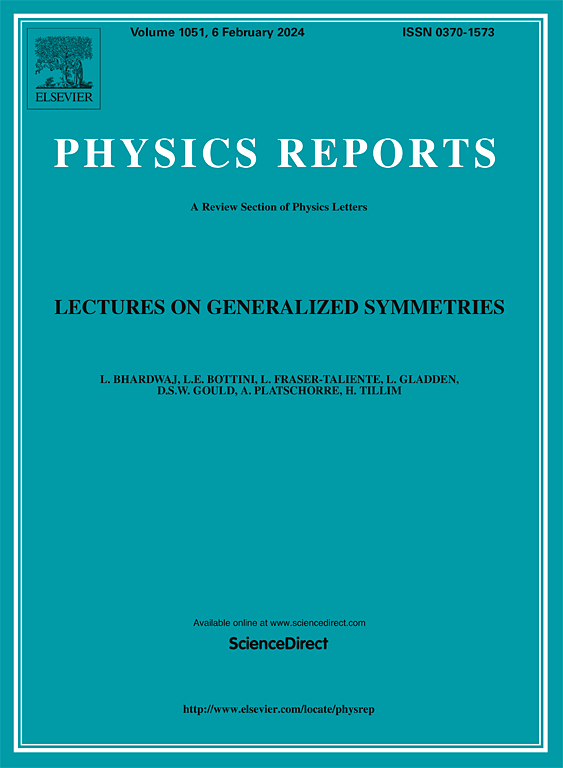A comprehensive review of particle-laden flows modeling: Single/multiphase modeling approaches, benchmarks, heat transfer, intermolecular interactions, recent advances and future directions
IF 29.5
1区 物理与天体物理
Q1 PHYSICS, MULTIDISCIPLINARY
引用次数: 0
Abstract
Understanding the profound complexity of particle-laden flows is critical to advances across multiple disciplines. This review aims to provide a comprehensive framework for understanding these multiphase systems, addressing both their fundamental physics and diverse modeling approaches. By beginning with effective single-phase models that are characterized by their homogeneous mixture properties, the review sets a foundation for exploring more advanced techniques.
The presentation then transitions to multiphase models, where advancements seek to overcome the limitations of single-phase approaches. The mixture model, valued for its simplicity and computational efficiency, struggles to capture detailed interphase interactions. This challenge leads to the multiphase Eulerian models, which treat fluid and particle phases as interpenetrating continua. The Eulerian–Lagrangian approach emerges to address the need for higher fidelity, enabling detailed tracking of individual particles, whether point-like or resolved, in the fluid. Fully Lagrangian models further refine the focus on particle dynamics, offering specialized insights despite significant computational demands.
The dynamics of particle-laden flows are shaped by the interplay of forces among particles, fluids, and surfaces. Forces such as drag, lift, Magnus, and Brownian, along with thermophoretic, van der Waals, and electrostatic interactions, govern the individual particle motions. External influences, including acoustic radiation, Lorentz forces, and gravity, add complexity to these interactions. Scaling analyses provide clarity by identifying dominant dynamics across varying spatial and temporal scales.
Benchmark studies play a pivotal role in validating these models. Classical test cases, ranging from single-particle sedimentation to particle–particle dynamics, thermal migration, and Brownian motion, highlight the challenges of integrating particle transport phenomena across scales. Heat transfer mechanisms in particle-laden flows introduce another layer of complexity. Conduction, convection, and radiation interact with particle motion to shape the thermal behavior of particle–fluid suspension. At higher speeds, the multiphase mixture transitions to turbulent flow, and turbulence modeling approaches are used to analyze the chaotic flow regimes.
The techniques described in this article deepen the understanding of the complex hydrodynamic and thermal behavior of particle-laden systems, which are critical in numerous engineering and scientific applications. In addition, the review systematically explores the applications of particle-laden flows, identifying commonly used modeling approaches for various conditions. It further highlights the key forces influencing specific applications, offering critical insights into their significance and practical implications.
Ultimately, this review attempts to provide an essential and thorough guide for researchers and scholars exploring particle-laden flow and heat transfer dynamics. It also aims to critically examine the underlying physics of particle-laden flows, offering insights into the intricate and multifaceted nature of this widely studied yet challenging phenomenon.
全面回顾颗粒负载流建模:单/多相建模方法,基准,传热,分子间相互作用,最近的进展和未来的方向
理解微粒流的深刻复杂性对于跨多个学科的进步至关重要。这篇综述旨在为理解这些多相系统提供一个全面的框架,解决它们的基本物理和不同的建模方法。本文从具有均匀混合特性的有效单相模型入手,为探索更先进的技术奠定了基础。然后演示过渡到多相模型,其中的进步寻求克服单相方法的局限性。混合模型因其简单性和计算效率而受到重视,努力捕捉详细的间期相互作用。这一挑战导致了多相欧拉模型,该模型将流体和颗粒相视为相互穿透的连续体。欧拉-拉格朗日方法的出现是为了满足对更高保真度的需求,能够对流体中的单个粒子进行详细的跟踪,无论是点状的还是分解的。完全拉格朗日模型进一步细化了对粒子动力学的关注,尽管需要大量的计算,但它提供了专门的见解。微粒流的动力学是由微粒、流体和表面之间的力的相互作用形成的。阻力、升力、马格努斯力和布朗力,以及热泳、范德华和静电相互作用,控制着单个粒子的运动。外部影响,包括声辐射、洛伦兹力和重力,增加了这些相互作用的复杂性。尺度分析通过在不同的空间和时间尺度上识别主导动力提供了清晰度。基准研究在验证这些模型方面起着关键作用。经典的测试案例,从单粒子沉降到粒子-粒子动力学、热迁移和布朗运动,都突出了跨尺度整合粒子输运现象的挑战。颗粒流中的传热机制引入了另一层复杂性。传导、对流和辐射与颗粒运动相互作用,形成颗粒流体悬浮液的热行为。在较高的速度下,多相混合物转变为湍流,湍流建模方法用于分析混沌流型。本文中描述的技术加深了对颗粒负载系统的复杂流体动力和热行为的理解,这在许多工程和科学应用中至关重要。此外,该综述系统地探讨了颗粒负载流的应用,确定了各种条件下常用的建模方法。它进一步强调了影响具体应用的关键力量,提供了对其重要性和实际影响的关键见解。最后,本综述试图为研究粒子负载流动和传热动力学的研究人员和学者提供必要的和全面的指导。它还旨在批判性地检查颗粒负载流的潜在物理,为这一广泛研究但具有挑战性的现象的复杂和多方面的本质提供见解。
本文章由计算机程序翻译,如有差异,请以英文原文为准。
求助全文
约1分钟内获得全文
求助全文
来源期刊

Physics Reports
物理-物理:综合
CiteScore
56.10
自引率
0.70%
发文量
102
审稿时长
9.1 weeks
期刊介绍:
Physics Reports keeps the active physicist up-to-date on developments in a wide range of topics by publishing timely reviews which are more extensive than just literature surveys but normally less than a full monograph. Each report deals with one specific subject and is generally published in a separate volume. These reviews are specialist in nature but contain enough introductory material to make the main points intelligible to a non-specialist. The reader will not only be able to distinguish important developments and trends in physics but will also find a sufficient number of references to the original literature.
 求助内容:
求助内容: 应助结果提醒方式:
应助结果提醒方式:


